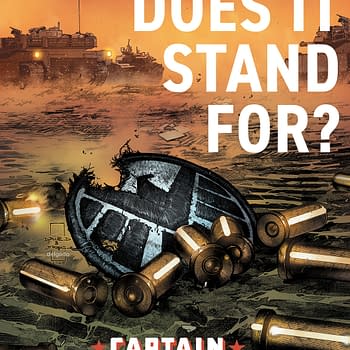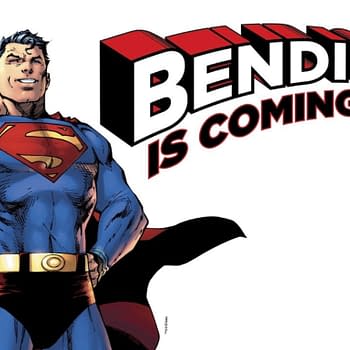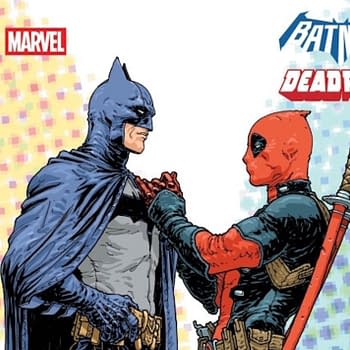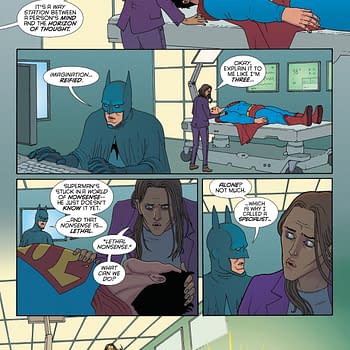Posted in: Comics | Tagged: Comics, entertainment, kickstarter
11 Things All Failed Kickstarter Projects Do Wrong
Hi, if you don't know me, my name is Paul Roman Martinez. I'm an artist, illustrator, and designer. I've run three successful kickstarter campaigns in the comics and tabletop games categories, and I'm in the middle of my fourth: The Flight Deck Playing Card series based on early airship and airplane designs. The campaign runs until April 1st!

1) Poor Thumbnail
It may seem like a small detail, but the thumbnail image is the key to the project. It is the first visual representation of your work. Imagine it this way: Food companies put millions of dollars into developing their packaging so that their boxes stand out on a shelf amongst dozens of other boxes. Just like someone pushing a cart through an aisle of groceries, people are scrolling through crowded pages full of projects waiting for something to catch their eye.
Here's What You Do:
Go to kickstarter and browse the section you want to be listed in. Take a screenshot of the projects when they're all listed on a page together and pick one to photoshop your project thumbnail over. You will use this photoshop image to design your perfect project thumbnail. Adjust the color and layout so that the most distracted browser can easily spot it amongst all the other thumbnails. A good project thumbnail is interesting but also tells people at a glance what they are backing.
2) Poor Project Title and Subtitle
If you managed to get a browser's attention with your thumbnail, the next thing they're going to look at is your Title and Subtitle. This is the only text they can see through the browsing page and will contain the most important keywords for the search function. What is your project? What themes does it contain? You have to ask yourself what things your potential backers are looking for. I've seen—even experienced—project creators mess this up. I saw a project creator who had made about 8 different projects, many of which went over $100,000 and one over $500,000, decide to go with a simplified title. It was only a couple words and didn't really explain what the project was. I think he was hoping to tempt people to click the link by being mysterious; I guess he figured after grossing close to a million dollars total on his projects, he could start taking some risks. Well, the project did not show up in any of the standard searches his previous backers would be making. I went to the forums exclusively for fans of the type of product he makes, (I'm being cryptic here about their product, can you tell?) and no one was talking about him. It was like a secret campaign no one knew about and it received a tiny fraction of his previous project's funding.
Here's What You Do:
Go to kickstarter and find someone making something like yours. Get specific. Are you making a space themed comic book? Search "space comic book." Are you making an Old West themed tabletop game? Search "Old West" in the tabletop games section. Do this a lot for a lot of different keywords. If you do it enough, you will start seeing some repeats at the top. Those are the people who, no matter what search terms you used for "space comic book" or "Old West tabletop game," have figured out a way to show up. That's what you need. And do this while the project is running as well. Don't be afraid to change what's not working. If you're producing an Old West game that features horses prominently, for example, and halfway through you realize you're getting a lot of equestrian fans because of your fully painted horse cards, then throw some keywords in for them. Mention horses in the subtitle! You do not want a single Old West fan to miss your project because you forgot an important key word in your subtitle or main title.
3) Unclear Description of the Product and the Goal
This one should be easy. You know exactly what you need the money for, so your backers should know too, right? Well I see people screw this one up more times than I can count, especially in the comic book section!!! I know you want to tell us what your book is about. I know it has a great story arc involving a Sci-Fi post-apocalyptic future with robots that transform into steampunk zombies to fight off the coming of Chtuhlu (that's my next project; don't steal it). But you need to put at the top of your project in clear letters in less than two sentences what you are actually making. Is it a comic? How many pages? What dimensions? Color or B+W? These things should be there at the very top. Is it a tabletop game? How many players? How long does the game take to play? What ages? What does it come with?
Here's What You Do:
Come up with a new elevator pitch for your project. I know you've spent months honing the perfect two sentences to describe the plot of your book or your game, but now you need the perfect two sentences to describe what you are doing with all your awesome backers' money! And then, hit return twice and start writing your plot summary.
4) No Prior Fan Outreach
If a tree falls in the forest and no one is around to hear it, does it make a sound? If a project launches on kickstarter and you have no fans and maybe 150 facebook friends, does anyone notice? People are always asking me how to get more backers to see their projects—how to get more pledges. Well the real work to reach backers can start over a year before you launch. The best way is to build up your social networking presence. You start posting development pictures early. If you don't have development pictures, start a pintrest with pictures of projects similar to yours. Whatever you do, just start it early. If you set up a facebook page two weeks before your project launches and hope your project will go viral because you want it to, then you're out of luck.
Here's What You Do:
Start connecting on every social media network you can and start early! Learn how the different networks work. Getting traction with a post on Reddit is totally different than getting traction on Facebook or Pintrest. But most of them start with a great image. Take the best image you can and start pimping that around. If it doesn't take off in one section, wait a few days and try again with a different set of keywords or a different way of phrasing your heading. Look at what topics are trending in the Reddit sections for your type of project. How did they do it? The social networks change so often that there is not a single one I would recommend over the others. I can tell you right now, though, that you can get just as much attention with some great keywords and well placed pictures as you can with paid ads.
5) Not Explaining Why You are Qualified to Produce this Project
Maybe the art looks great; maybe the game looks great; maybe it all looks awesome. I've seen a lot of projects like that. Then I look at everything that is going into them and the amount of money they are looking for and I think, there's no way this one person can pull this off. Depending on the scope of the project, you might need help. People are giving you money for a product that doesn't exist yet. Now that Kickstarter has gone mainstream, there are tons and tons of people on there who think they can make money quickly with a project and then they're in business. It takes a lot of skill to produce a good book, and it takes a lot of different types of skills to produce a great tabletop game. I tell people that self publishing my own tabletop game felt like sending five books to the printers at once. Every piece has to be prepared differently. Each part has a separate template and set of die lines and a different set of materials for you to sample and decide on. And all of this has to be done on a deadline.
Here's What You Do:
Do your homework and then TELL people you've done your homework. Tell them about the hours you spent on forums getting feedback on your design. Tell them on your page about different printing techniques you're researching. And also, make a mockup. Get into photoshop and manipulate an image to look like the cover of your book or game. Yes, maybe the game or book isn't done yet, but you need to be able to get your backers to picture it. And if you can't picture it, how will they?
6) Not Enough Art on the Page
Both comic books and tabletop games are very visual mediums. Yes, they contain a lot of writing and gameplay, but what sells these mediums first? The visuals. Unless I'm looking at a project to review it, I usually don't watch the videos for the projects I back. That's right–I just skim the page. If I like it, I'll back it. I'm sure a lot of people use Kickstarter this way. I've seen projects that have awesome videos but their pages aren't filled in. That just doesn't hook me. Did you know there are tons of people on Kickstarter who have backed a hundred projects or more? These power backers are on there every day, commenting on projects and reading updates. The video is a small two-to-five minute portion of the project experience. When pages aren't there, or closeup of card artwork isn't present, the whole project looks suspicious.
Here's What You Do:
Put some pages up. Sounds easy enough, right? But you'd be surprised. Put up some images with character bios if your comic is new; they don't have to be long. Create some headers for sections of your pages in photoshop. Create some visual breaks in the product page. For tabletop games, you're going to need multiple videos. One for gameplay, one for artwork, and maybe one for unboxing if you have a good demo. They don't have to be long or super awesome, they just have to exist.
7) Not Enough Interaction with Backers
Yes, I'm sure there have been successful six-figure projects that only did three updates and made two or three comments on their project pages, but these are not the norm. When I look at a great product and try to figure out why it didn't get funded I immediately look at the comments and the updates. In the comments section, people can voice their frustration about a project, ask questions, or just say good luck. And the updates section is a great way to keep backers up to date and let them know you are working your ass off to create an awesome project.
Here's What You Do:
Make the first comment. Go ahead and do it. A lot of people are nervous and don't want to be the first one to comment. Do it for them. Respond to every single comment. Do it; why not? Of course, if you get a super backer commenting a lot, you can always wait and respond to a couple at a time. But respond! Let these people know you are there if they need to ask or say something. And post an update every two to four days. There is no excuse for running a thirty day plus project and only having 3 updates. Is your project so boring you can't think of a single new thing to say about it?
8) Not Treating the Kickstarter like an Event
This sort of goes along with comments and updates. What is a kickstarter campaign? For some it is a new and strange thing, like going to senior prom stag. You don't know why you're there, and you're not going to talk to anyone. For others it's become a routine part of business, and they have it down to an exact and very boring science. I've launched four projects for three very different products with three very unique fan bases. I've had the luxury of learning a whole new world with almost every campaign. If you want your kickstarter to be an event, then you need to make it an event.
Here's What You Do:
You bring the party. Find reasons to create updates and find reasons for people to read them. Yes it is great to thank people, but who wants to read twenty updates filled with you being thankful and humbled by the support. Offer them new information. Show them pictures of you doing game testing. Show them pencils for pages in progress. Update them on manufacturing details, like receiving samples. If you can, save some surprise rewards to unleash during the project, especially during the dog days in the middle. Go to kicktraq.com and look up some succesful projects. Every one of them has a slump in the middle where they may even lose money. But good projects find a way to get new backers during those days. I have looked at projects with a spike in the middle. And everytime I see a spike, I can trace it back to the day it happened, look at their updates, and sure enough, it's because they announced some super cool new feature about their projects. And no, I'm not just talking stretch goals.
9) Confusing Pledge Levels
Some projects by nature will end up with a lot of different pledge levels. My playing card project almost doubled in pledge levels when I introduced some new limited edition decks. It can't always be helped. But I have seen projects where I can't even tell what pledge level the physical book comes in! If I have to spend more than three minutes reading the same three pledge levels in my price level over and over again to figure out which one comes with what, then I'm going to just move on to the next project.
Here's What You Do:
Write all of your pledge levels out on a document. Make sure you're using the same nomenclature for rewards across the board. That means if you have a 1 Screenprinted T-shirt reward offered, don't call it a t-shirt further down the page because you got tired of capitalizing the "T." If you write the rewards the same way every time, it will make it easier for your backers to see what new items are popping up in later reward levels. If you can, make a graphic for all the reward items and show reward tiers visually. Not every project will have the space for this, but if you do, visual representations of levels can go a long way.
10) Missing or Poor Video
There is no excuse to have a project with no video. Almost everyone has a phone with a camera on it, so when I see a project with no video, it just looks lazy to me. Or it looks like they're not very serious about the project. The video is a great place to get on the screen and talk a little about what you're trying to accomplish. If you have no video, then you just missed an opportunity to humanize your project and put a face to all the hard work people are seeing.
Here's What You Do:
Make a video, or get someone to make it for you. It doesn't have to be long. At it's simplest, it can be you sitting in a chair in your office describing what your goal is. From there, the sky is the limit. You can overlay artwork from your book or show yourself drawing a page. Time lapse drawing videos are always popular. If you have a tabletop game, you need to show gameplay. You just have to—there's no avoiding it!
11) Confusing or Incomplete Shipping
Did you know a kickstarter can raise all the money they need and still be a complete failure? We've all seen plenty of projects that ran out of money and couldn't afford to ship the products to their backers who helped pay for it. Don't be that person. If you don't raise the funding you need, you can always re-launch a project and try again after you make some tweaks. But if you fail to deliver, or worse yet, deliver to stores and not your backers, then you may never get to run another crowd funding campaign again.
Here's What You Do:
Get a scale. They're cheap! Go do it. Package up some stuff that is the size of the product you're making. Go on google maps and look up the address of a Starbucks at the farthest point in the country you are in and estimate shipping. Then, find a Starbucks in France or Australia (two of the most expensive countries for me to ship to from the United States) and estimate shipping to those addresses. Also look up Canada. If you live in South Florida or Southern California like me, then shipping to Canada can be just as expensive as shipping to Great Britain. And make sure whatever surcharge you place on shipping you explain to your backers. If you've done your homework and priced everything out properly,m then you shouldn't have much to explain. You can just say, I checked the prices, and that's how much it costs!
So there you have it—11 ways to keep your crowdfunding campaign from failing. I guarantee that if you follow these steps, you will have an interesting campaign that will at least entertain some backers along the way. Whether or not you will make a profit, well, I can't guarantee that!
If you get a chance, stop by my project and take a look!














